The Columbine High School mass shooting on 20 April 1999 signified a terrifying change in mass violence and the use of guns in schools, to the extent that this phenomenon has been named the Columbine Effect. Thirteen people were killed on that day with twenty-four wounded at the hands of two teenage boys who had planned the attack for months, and who at the end of their rampage took their own lives.
Since Columbine in 1999, there has been an increasing trend of mass shootings, particularly across America. The Gun Violence Archive report there have been 124 mass shooting incidents this year alone, with 23 of those taking place on school grounds, according to a CNN report in 2018.
With the overwhelming number of these shootings being carried out by young adult males, understanding why teens and young adults are taking such extreme actions within schools is the key to implementing policies and strategies to try and prevent such tragedies from happening again.
“In a study of active-shooter incidents, FBI officials said there were 160 cases from 2000 through 2013, with the numbers growing from an average of 6.4 incidents in the first seven years to 16.4 in the last seven years. Seventy percent of the shooters attacked in schools or workplaces, and 60% of the shootings happened so fast that they were over before the police arrived. In 40% of the cases, at least three people were killed, not counting the shooter.”
School rampage shootings are not just taking place in America. In Canada, Sweden, Bosnia, Australia, Argentina, Germany, and Finland, entering a school armed with weapons and opening fire on innocent students and employees has become a deathly method of expression for some troubled individuals.
Worryingly it appears often these incidents are imitations of previous rampage school shootings, where other individuals have been keen to make their name through death and devastation.
In May 2013 in Oregon, 17-year-old Grant Acord hid a cache of explosives in his bedroom and was planning an attack on his high school where he wanted to make a ‘more successful version’ of the Columbine massacre. Caught before he could carry out such an attack he was charged with aggravated attempted murder. In March 2014, 18-year-old Natalie Carpenter and 19-year-old Peter Thulin planned a shooting at Danbury High School with Peter Thulin reportedly being ‘obsessed’ with the Columbine shootings.
The list continues, 17-year-old David LaDue in Waseca, Minnesota, plotted to shoot his family and as many students at his school as possible before shooting himself. Two 15 and 16-year-old boys in Trinidad, Colorado were arrested for planning an attack on their local high school….all idolized the Columbine Massacre. In Tampa Bay, Florida 17-year-old Jared Cano was arrested for a bomb plot and shooting plan against Freedom High School in an attempt to ‘outdo’ Columbine.
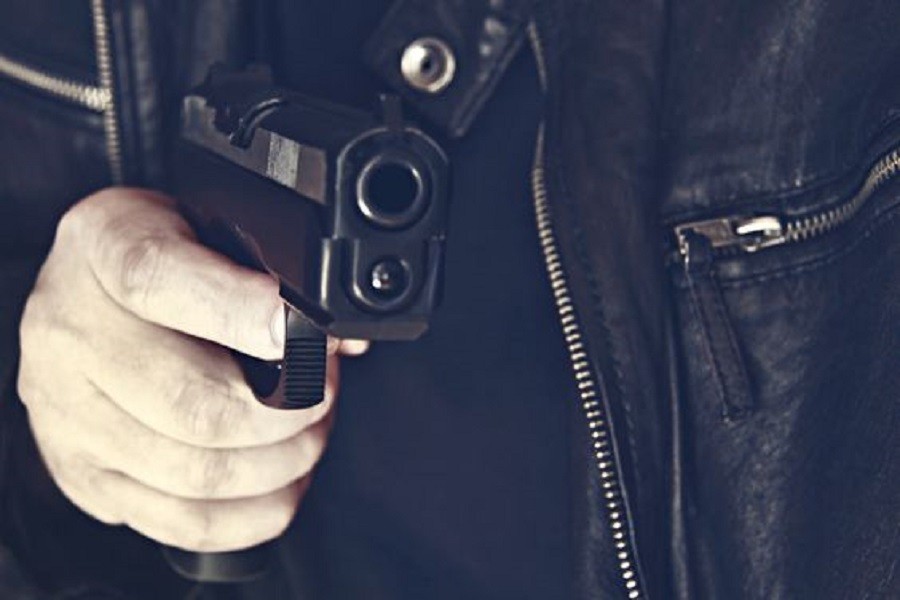
The Columbine Shooting
The Columbine High School massacre, as it is now known, was the most reported and publicized event within the 1990’s next to the O.J. Simpson car chase of June 1994. Across the world images of Eric Harris and Dylan Klebold storming into Columbine High School in Colorado armed with ninety-nine bombs, three guns, and four knives were broadcast as they randomly opened fire on fellow classmates before turning their weapons on themselves.
These two 18-year-old boys had spent months designing and planning a devastating attack on their own high school. Diversions were set to delay emergency services reaching the school; bombs were rigged to cars with planned detonations in various locations around the school to create as much chaos as possible and kill as many as they could. They had written journals detailing their plans and intentions citing the Oklahoma City Bombing as their inspiration.
Websites detailed their increasing animosity towards society and certain individuals were found, while they recorded chilling videos of themselves with guns and explosives, carrying out target practice deep in the woods near their homes.
In a report published in Slate Magazine in April 2004, five years after the massacre, Dave Cullen the author of the book ‘Columbine’, reported the findings of a summit where a collection of mental health experts, psychiatrists, and FBI agents gathered to discuss the motives and reasons for the attack on Columbine High School. The report stated;
“They bragged about dwarfing the carnage of the Oklahoma City bombing and originally scheduled their bloody performance for its anniversary. Klebold boasted on video about inflicting “the most deaths in U.S. history.” Columbine was intended not primarily as a shooting at all, but as a bombing on a massive scale. If they hadn’t been so bad at wiring the timers, the propane bombs they set in the cafeteria would have wiped out 600 people. After those bombs went off, they planned to gun down fleeing survivors. An explosive third act would follow, when their cars, packed with still more bombs, would rip through still more crowds, presumably of survivors, rescue workers, and reporters. The climax would be captured on live television. It wasn’t just “fame” they were after—Agent Fuselier bristles at that trivializing term—they were gunning for devastating infamy on the historical scale of an Attila the Hun. Their vision was to create a nightmare so devastating and apocalyptic that the entire world would shudder at their power.”
Harris, they said, was a psychopath. An individual who knew exactly what he was doing, why he was doing it and he did it because he wanted to. Klebold had a temper but he was also “depressive and suicidal”, removing blame from himself for his problems and blaming those around him.
“Harris’ pattern of grandiosity, glibness, contempt, lack of empathy, and superiority read like the bullet points on Hare’s Psychopathy Checklist and convinced Fuselier and the other leading psychiatrists close to the case that Harris was a psychopath.”
Their assessments of Harris from the countless journals, videos, and other written materials he left behind have convinced experts that it was Harris who was the leader of the pair. An 18-year-old who had no sympathy or care for his victims or the devastation he was about to cause.
The Columbine Effect
The Columbine school shooting was not the first, but it was the deadliest at that time, and its effects have been widely felt. The Columbine Effect is a term coined by the media to explain the influence the Columbine shootings had. Schools increased their security and threats of violence against other students were taken more seriously.
Schools began to talk to each other about students with violent criminal histories or showing troubling signs and students who had verbal threats of violence made against them were quicker and more willing to report it. But the effect of Columbine has also reached other individuals in a way that no one predicted.
These are people who believe Harris and Klebold were bullied and mistreated teens amongst their peers and that has given them a sense of awe in the actions in which these two took on that day in 1999. For some Harris and Klebold have become ‘heroes’ who stood up for themselves and made a change.
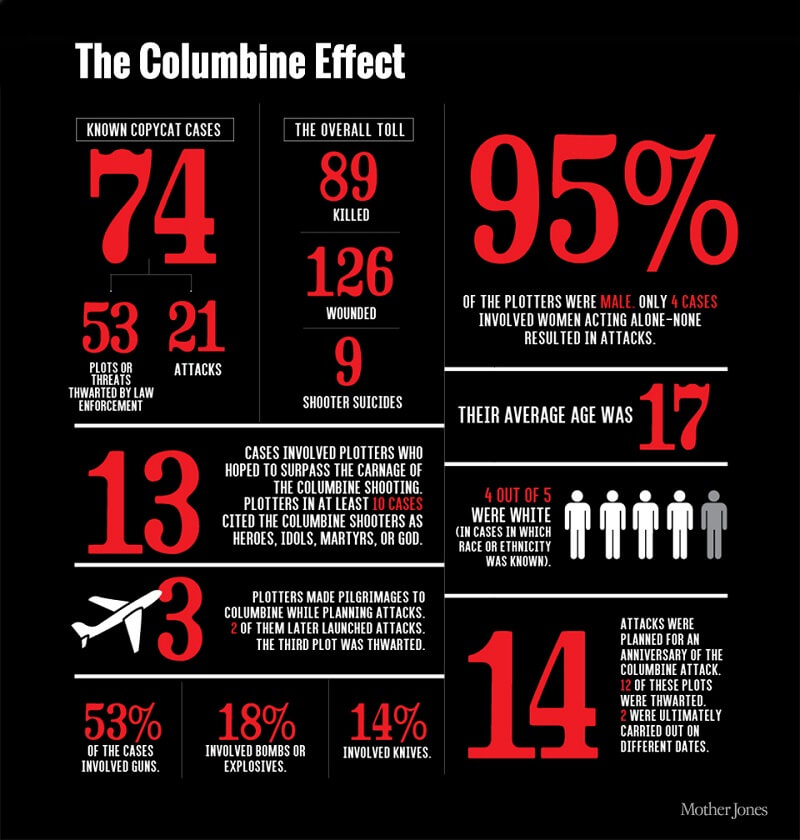
In 2009, a research study by Ralph Larkin from the John Jay College of Criminal Justice at the City University of New York set out to examine the impact and influence of the Columbine school shooting. In his research, he wanted to see exactly how school rampage shootings carried out after 1999 were influenced by the Columbine shooting.
Rampage shootings are classified as those where victims are random and the shooter has opened fire killing anyone they see or anyone unfortunate enough to cross their path. Rampage shootings are an attack on multiple people in a public place with a school being a common venue.
Twelve school rampage shootings were recorded between 1999 and 2007 after Columbine took place. Eight of which (67%) directly referred to Columbine, either in the shooters own admission or in notes and written materials left behind. All shooters were male and in the shootings at Conyers, Georgia, Fort Gibson, Oklahoma, East Greenwich, New York, Red Lake, Minnesota, Hillsborough, North Carolina and Virginia Tech University, copycat traits were found with evidence that these involved imitations of the Columbine attacks. In the school shootings which took place outside of the United States, six out of the eleven found had direct references to Columbine.
Alongside school shootings which have been carried out, a number of planned attacks on schools have been foiled before they had the chance to take place.
The ‘Contagious’ Nature of School And Mass Killings
A study published in PLOS ONE in July 2015 from Arizona State University has suggested school shootings and mass killings spread “contagiously”. Researchers believe that the extensive national media coverage such events create plays a role in this effect. According to this research, there is a mass killing in the United States approximately every two weeks, with a school shooting taking place about once a month.
This study investigated mass killings, where four or more people were killed, school shootings, and mass shootings where at least three people were shot but not necessarily killed, in the United States. They used a mathematical contagion model to analyze the data where a contagion model is the idea that there is a spread or transmission of a variable from person to person.
This type of model is commonly used statistically within finance sectors but has also been applied in many other areas such as social economics and terrorist attacks. It is believed this study is the first to use such a model to examine mass shootings.
Their results suggested there was a significant effect of contagion within mass shootings, where researchers describe their findings in terms of an infection that spreads. Once other vulnerable individuals hear about mass shootings taking place they are more likely to commit a similar crime. They note that local news coverage does not have the same contagious effect. It is national news coverage of the larger more deadly mass shootings where this risk is present.
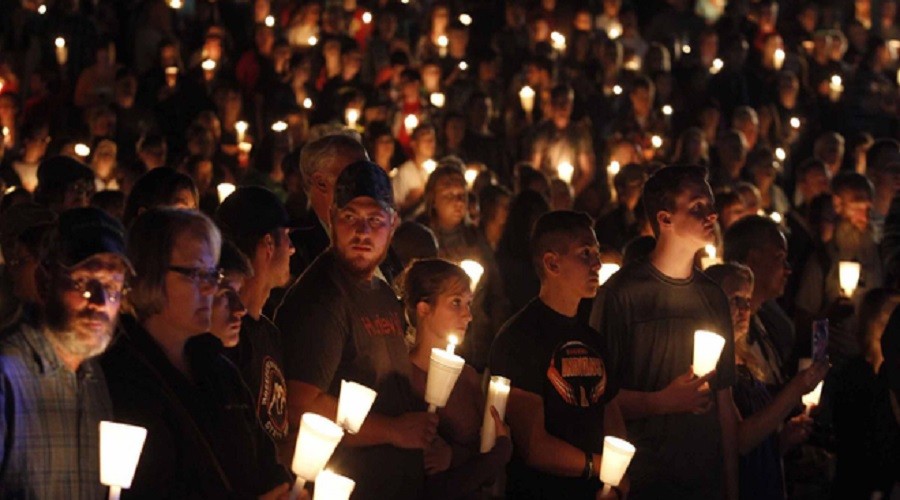
The ease of access to weapons within school mass shootings is also thought to be a factor in the number of shootings and frequency of incidents we are seeing in the United States.
The United States has the highest rates of firearm ownership compared to other countries and analysis of school mass shootings has shown that 67% of shooters obtained the weapon or weapons they used from their own home.
There are many troubled young adults in the world but few will go on to commit such horrific crimes as the Columbine school shooting. As highlighted by the expert summit into that incident, Eric Harris may well have been a psychopathic individual showing all the traits of a person on a collision course with danger and at high risk of causing harm to other people.
For some, the perception, even though it is incorrect, that Harris and Klebold were making a stand for themselves and everyone else who felt mistreated and unaccepted, has provided them with identification with two killers and possible ideation on taking their own ‘revenge’ in their own worlds. For others, revenge may not be their motive; it may be rage, it may be despair or it may be a simple desire for headlines and national recognition.
A single motive may be impossible to find in the complex psychology of any individual. However, the similarities and imitation traits found in many mass shootings relating to previous mass shootings, especially Columbine, highlight the influence of such incidents and the danger they pose months and years after the actual events.
References
- Ahmed, S., and Walker, C. (2018) There Has Been, On Average, 1 School Shooting Every Week This Year. CNN.
- Cullen, D (2004, April 20) The Depressive and the Psychopath – At last we know why the Columbine killers did it. Slate Magazine.
- Gun Violence Archive. Retrieved from http://www.gunviolencearchive.org/
- Larkin, R. (2009) The Columbine Legacy – Rampage Shootings as Political Acts. American Behavioural Scientist. 59(9) pp1309-1326
- Serrano, R (2014, September 24) Mass shootings in U.S. have tripled in recent years, FBI says. Los Angeles Times.
- Towers, S., Gomez-Lievano, A., Khan, M., Mubayi, A., & Castillo-Chavez, C. (2015). Contagion in mass killings and school shootings. PLoS One, 10(7), e0117259.
- Woolf, N (2015, October 2) Oregon college shooting is 994th mass gun attack in US in three years. The Guardian.
Cite This Article
Guy, F. (2015, Oct 4). Columbine Effect and Mass School Shootings. Crime Traveller. Retrieved from https://www.crimetraveller.org/2015/10/columbine-effect/
- Columbine by Dave Cullen – The definitive account of the Columbine High School shooting of 1999, Columbine is above all a compelling, tragic and utterly human portrait of two young killers.
- Dark Dreams: A Legendary FBI Profiler Examines Homicide and the Criminal Mind “Hazelwood has helped track down some of the most violent and well known criminals in modern history. The cases he describes are as shocking as they are perplexing; their resolutions are as fascinating as they are innovative.”
- Serial Killers: The Method and Madness of Monsters Vronsky not only offers sound theories on what makes a serial killer but also provides concrete suggestions on how to survive an encounter with one.

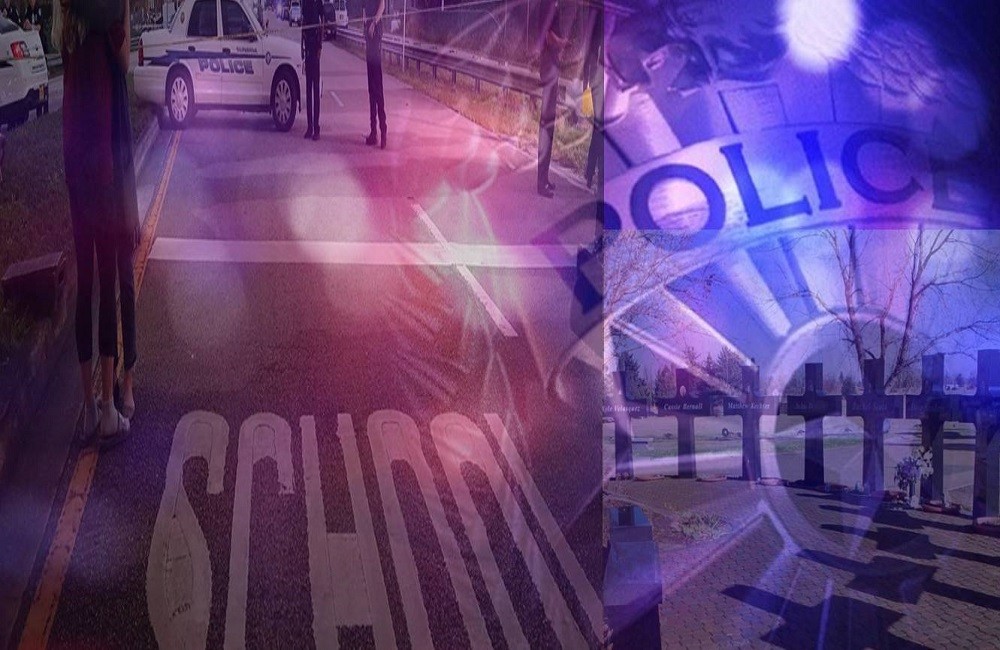
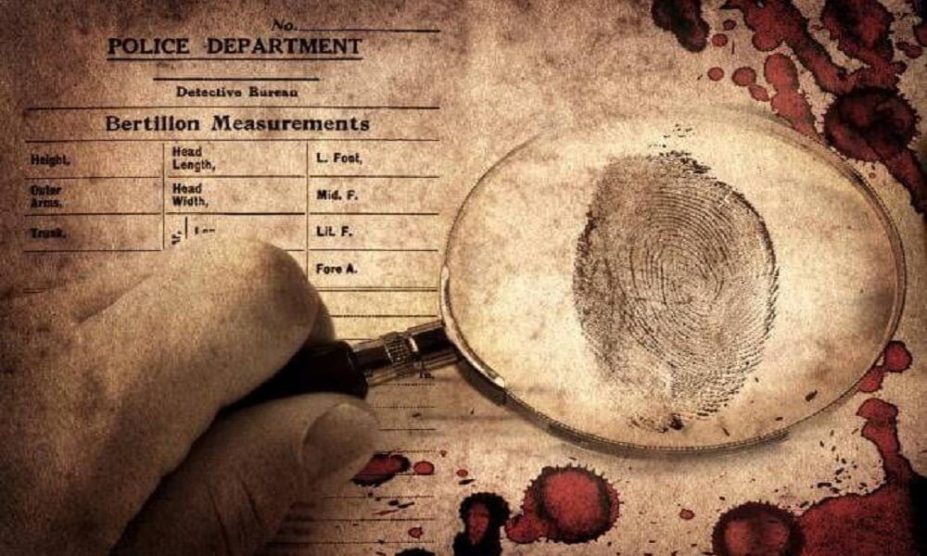
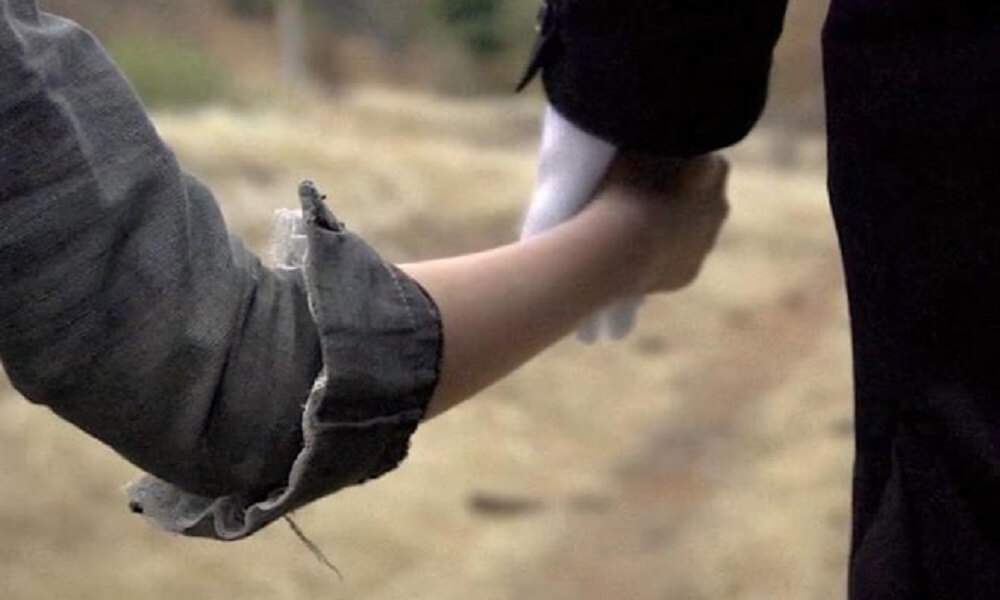
Excellent post CrimeTraveller, really interesting read! It is so sad that some people decide to do something like this. I was surprised to learn of the amount of other mass shootings which have reference to the Columbine school shooting. I knew there was a 'following' if you want to call it that, but not that people have actually been carrying out shootings trying to copy that one. When you read about mass shootings the focus always seem to be on America, but clearly these are also happening in other countries too. As you say, very worrying.
Thank you Valerie, this one was a really interesting one to write and I learnt a lot doing it. I have always found the psychological process intriguing for crimes like this, how someone goes from possibly thinking about carrying out such an attack to actually doing it. I too was surprised at the sheer amount of links and references to the Columbine shooting there were in the many mass shootings there have been since 1999. I also found the report by Dave Cullen on the conclusions of the expert summit held really very interesting, as is his book 'Columbine' which if you haven't read, I would highly recommend.
I thank you so much for your time in writing this post.